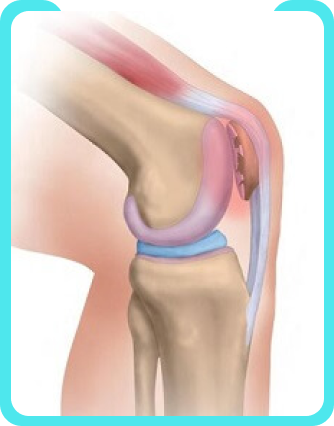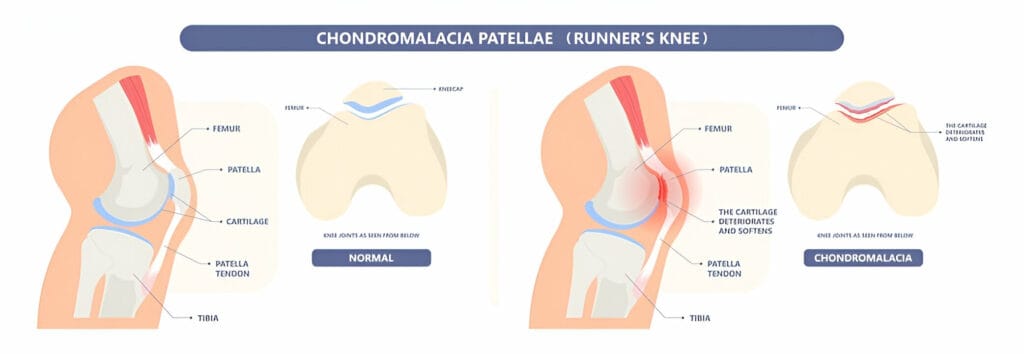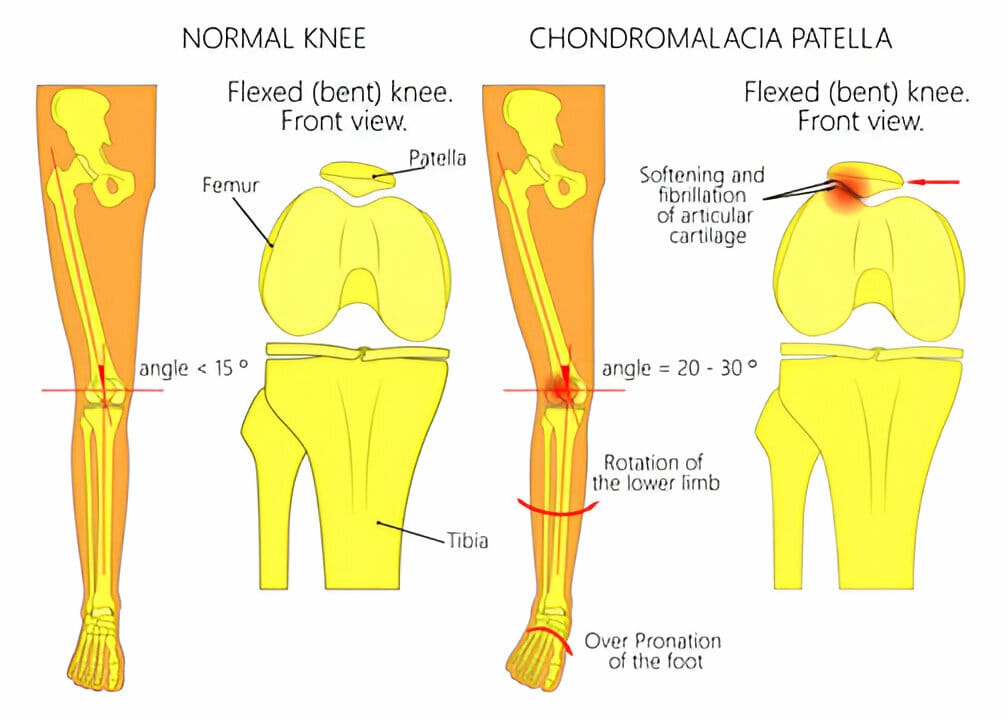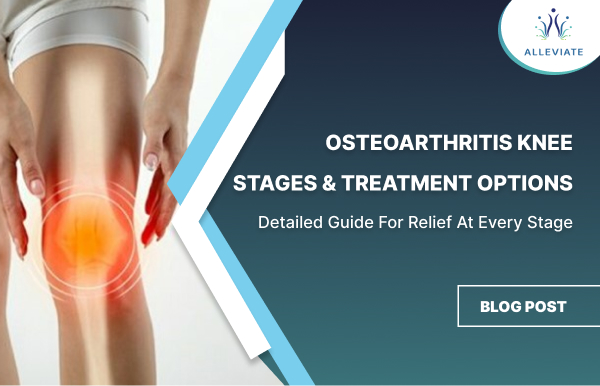
Chondromalacia Patella: Treatment & Doctors in Bangalore
- Home
- Conditions
- Knee pain
- Chondromalacia Patella
What is chondromalacia patella?
Chondromalacia Patella, also known as “runner’s knee,” is a condition where the cartilage on the underside of the patella (kneecap) deteriorates and softens. This leads to pain and inflammation in the knee, particularly during activities that put pressure on the knee joint.
Treatment for Chondromalacia Patella
Anatomy of the Knee
The knee joint is one of the most complex joints in the body, consisting of:
Bones: The femur (thigh bone), tibia (shin bone), and patella (kneecap).
Cartilage: Smooth tissue that covers the ends of bones, reducing friction and absorbing shock.
Ligaments: Strong bands of tissue that connect bones and stabilize the knee.
Tendons: Connect muscles to bones, enabling movement.
Synovial Fluid: Lubricates the joint to minimize wear and tear.
Causes of Chondromalacia Patella
Overuse: Repetitive stress from activities like running, jumping, or cycling can wear down the cartilage.
Malalignment: Poor alignment of the kneecap due to congenital factors or muscle imbalances.
Injury: Direct trauma to the knee or previous injuries can damage the cartilage.
Muscle Weakness: Weak thigh muscles can lead to improper tracking of the patella.

Symptoms of Chondromalacia Patella
Knee Pain: Aching pain in the front of the knee, especially when bending the knee.
Swelling: Mild swelling around the kneecap.
Grinding Sensation: A grinding or crunching feeling when moving the knee.
Stiffness: Difficulty in fully extending or flexing the knee.
Prevention of Chondromalacia Patella
Exercise and Strengthening
Quadriceps Strengthening: Exercises like squats and leg presses to build strong thigh muscles.
Hip Strengthening: Exercises like clamshells and leg lifts to stabilize the pelvis and reduce knee strain.
Core Stability: Strengthening the core muscles to improve overall posture and alignment.
Proper Technique
Proper Footwear: Wear shoes with adequate support and cushioning to reduce knee stress.
Correct Exercise Form: Ensure proper form during physical activities to prevent extreme pressure on the knees.
Weight Management
Maintain a healthy weight to reduce the load on the knee joints and prevent cartilage deterioration.
Regular Stretching
Incorporate regular stretching routines to maintain flexibility and prevent muscle imbalances.

Chondromalacia Patella Treatment
at Alleviate Pain Clinic
- Purpose: Promote natural healing and reduce pain.
- Procedure: Injection of platelet-rich plasma derived from the patient’s own blood into the affected area.
- Benefits: Reduced inflammation, stimulated tissue repair, pain relief.
- Purpose: Stimulate tissue repair and reduce pain.
- Procedure: Injection of a solution (often dextrose) into the affected area.
- Benefits: Strengthened connective tissue, long-term pain relief, reduced inflammation.
Combined Approach
- Conservative Treatments: Physical therapy and lifestyle modifications to improve knee function and reduce pain.
- When to Consider Invasive Treatments: Persistent or worsening symptoms despite conservative management.
- Goals: Alleviate pain, restore function, enhance quality of life.
At Alleviate Pain Clinic, we offer non-surgical treatments for chondromalacia patella, including PRP and prolotherapy. Contact us to develop a personalized treatment plan to manage your condition and improve your quality of life.
FAQs - Chondromalacia Patella
People who are at risk for developing chondromalacia patella include:
- Those who are overweight
- People who have had an injury, fracture, or dislocation related to the kneecap
- Runners, soccer players, bicyclists, and other people who exercise often
- Teenagers and healthy young adults, more often females
Chondromalacia patella often occurs when the undersurface of the kneecap comes in contact with the thigh bone causing swelling and pain. Abnormal knee cap positioning, tightness or weakness of the muscles associated with the knee, too much activity involving the knee, and flat feet may increase the likelihood of chondromalacia patella.
Dull, aching pain that is felt:
- Below the kneecap
- On the sides of the kneecap
A feeling of grinding when the knee is flexed may occur. This can happen:
- Doing knee bends
- Going down stairs
- Running down hill
- Standing up after sitting for awhile
- Blood tests and/or a standard knee X-ray – This may help to rule out some types of arthritis or inflammation.
- MRI scan- A tests that shows details of the knee joint and can reveal many cases of chondromalacia patella.
- Placing of an ice or cold pack to the area for 15-20 minutes, four times daily, for several days. Do not apply ice directly to the skin. Wrap the ice or cold pack with a towel.
- Nonsteroidal anti-inflammatory drugs (NSAIDs) for pain relief. Topical pain medication— These include creams or patches that are applied to the skin to help with soft tissue pain.
- Prescription pain relievers.
- Changing the way you exercise
- Doing exercises to both stretch and strengthen the quadriceps and hamstring muscles
- Losing weight (if you need to)
- Using special shoe inserts and support devices
- Taping to realign the kneecap
- Wearing the right kind of sport or running shoes
Video Spotlight
Blog
Surgery-Free Solutions
Expert Tips for Pain Management
Testimonials
Words From Our Patients
The treatment was very good and the doctor Faraz Ahmed was very kind to the patient and explained clearly the procedure of knee bilateral ha & treatment And we were advised to do physiotherapy. We are very much satisfied. We would recommend this alleviate pain clinic. Thank you
Got treatment of Treatment and HA for right knee arthritis a month ago and finding good relief from pain. Was treated by Dr Swagtesh Bastia who explained very well about the injections and the treatment was painless. The front desk staff were very kind and very helpful and physiotherapy was also done expertly, overall good experience
Alleviate Pain Management clinic has been a godsend for my mom's knee pain. She has been treated by Dr. Wiquar Ahmed. The attentive staff provided personalised care, and after her treatment, she's feeling remarkably better. Thank you for giving my mom the relief she deserves!
The clinic is super clean with a great OT and most importantly all the staff here are very helpful and considerate. My gratitude to Dr Roshan, the nurses, and support staff - they were always available to assist with any issues post procedure and they even made an extra effort to make a home visit for a follow up check-up. This team here is the perfect example of healing and care with a human touch. Thank you!!!!!
My wife had knee pain I have visited alleviate pain and consulted doc santhoshi now she is able to walk pain free and can do her daily activity than before.the physiotherapist here Dr akhila also helped her with few exercises and the staff here Abdul explained all the procedures well . Thank you PPL can visit here for pain relief







